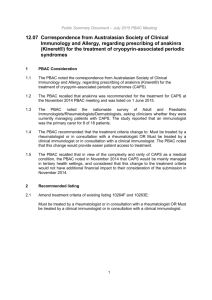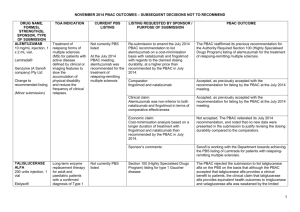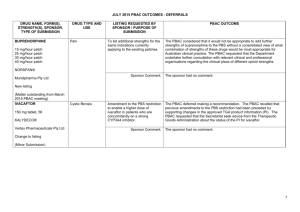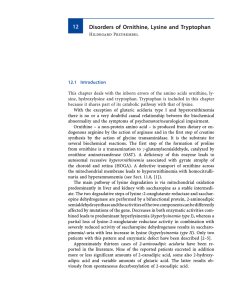5.26 amino acid formula
advertisement
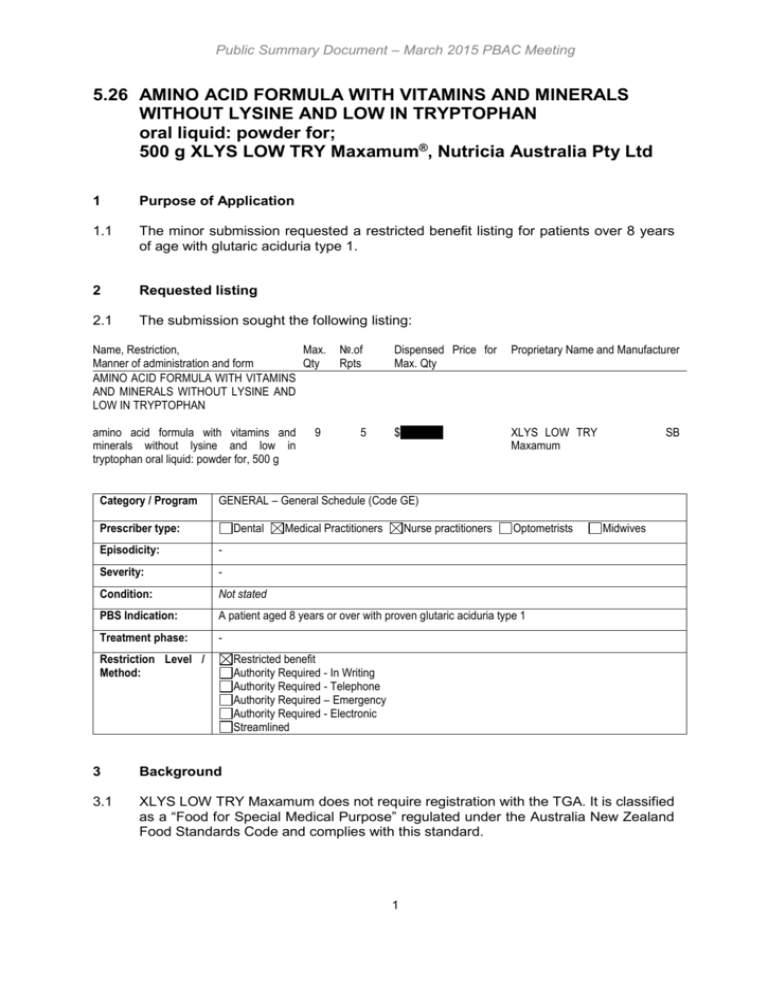
Public Summary Document – March 2015 PBAC Meeting 5.26 AMINO ACID FORMULA WITH VITAMINS AND MINERALS WITHOUT LYSINE AND LOW IN TRYPTOPHAN oral liquid: powder for; 500 g XLYS LOW TRY Maxamum®, Nutricia Australia Pty Ltd 1 Purpose of Application 1.1 The minor submission requested a restricted benefit listing for patients over 8 years of age with glutaric aciduria type 1. 2 Requested listing 2.1 The submission sought the following listing: Name, Restriction, Max. Manner of administration and form Qty AMINO ACID FORMULA WITH VITAMINS AND MINERALS WITHOUT LYSINE AND LOW IN TRYPTOPHAN amino acid formula with vitamins and minerals without lysine and low in tryptophan oral liquid: powder for, 500 g Category / Program 9 №.of Rpts 5 Dispensed Price for Max. Qty Proprietary Name and Manufacturer $''''''''''''''''''''' XLYS LOW TRY Maxamum SB GENERAL – General Schedule (Code GE) Prescriber type: Dental Medical Practitioners Nurse practitioners Optometrists Episodicity: - Severity: - Condition: Not stated PBS Indication: A patient aged 8 years or over with proven glutaric aciduria type 1 Treatment phase: - Restriction Level / Method: Midwives Restricted benefit Authority Required - In Writing Authority Required - Telephone Authority Required – Emergency Authority Required - Electronic Streamlined 3 Background 3.1 XLYS LOW TRY Maxamum does not require registration with the TGA. It is classified as a “Food for Special Medical Purpose” regulated under the Australia New Zealand Food Standards Code and complies with this standard. 1 Public Summary Document – March 2015 PBAC Meeting 3.2 In June 2002 and September 2002, the PBAC rejected submissions to list XLYS LOW TRY Maxamaid and XLYS LOW TRY Maxamum for the management of proven glutaric aciduria type 1 on the basis of inadequate evidence of effectiveness. 3.3 At its September 2006 teleconference, the NPWP advised that it supported the listing of the Maxamaid product for the dietary management of children with glutaric aciduria type 1. Although the NPWP did not advise of a particular age group for which the product should be PBS-listed for, the NPWP noted the following in September 2006: Children were previously identified when they had a neurological event, whereas currently (September 2006) they are identified much earlier due to screening for this condition at birth. There is an underlying pre-disposition for this condition and neurological damage is caused by a trigger. The ‘at risk’ period is up to 5 to 6 years of age. Therapy would be required from birth to 6 years of age by which time the brain has matured and is resistant to damage. Advice from members that new research (as at September 2006) has shown that carnitine supplementation and a lysine restricted diet are neuroprotective – reference Natural History, Outcome, and Treatment Efficacy in Children and Adults with Glutaryl-CoA Dehydrogenase deficiency, Kolker S et al (2006), Pediatric Research; 59(6): 840-847. Usage would be limited to approximately 6 patients per year. 3.4 Following consideration of the Working Party’s advice at its November 2006 meeting, the PBAC recommended listing XLYS LOW TRY Maxamaid for the ‘at risk period’ up to 5 – 6 years of age with a restriction on children until the age of 7. 3.5 At its May 2010 teleconference, the Working Party advised that for consistency and fairness, it would be appropriate to extend XYLS LOW TRY Maxamaid’s PBS listing to include children aged less than 9 years of age. The PBAC accepted this advice at its July 2010 meeting. 4 Comparator 4.1 The minor submission nominated GA Express 15® as the main comparator as it is the only powdered protein substitute for patients over 3 years of age which is most likely to be replaced by XLYS LOW TRY Maxamum. 4.2 The following products were noted to be currently PBS-listed for GA type 1: PBS Item GA express 15 GA gel GA1 Anamix infant XLYS, LOW TRY Maxamaid Restriction (Restricted Benefit) A patient aged 3 years or older with proven glutaric aciduria type 1 A child aged from 6 months up to 10 years with proven glutaric aciduria type 1 An infant or young child with proven glutaric aciduria type 1 A child aged less than 9 years with proven glutaric aciduria type 1 2 Public Summary Document – March 2015 PBAC Meeting 5 Consideration of evidence 5.1 The submission stated that patient acceptability trials were not conducted in patients with GA type 1 because this condition is extremely rare and fairly new. 5.2 The submission claimed that the clinical evidence examining the comparative efficacy of dietary supplementation in glutaric aciduria type 1 remains limited. The submission had referenced Kolker et al. (2011) as evidence of favourable outcomes with low lysine dietary supplementation and that this reference provided an update to Kolker et al. (2006). Estimated PBS usage & financial implications 5.3 The price requested was based on an equivalent price per gram of protein as GA Express 15. 5.4 The minor submission claimed that there would be no financial implications to the PBS as the submission expected XLYS LOW TRY Maxamum to substitute directly for GA express 15 which is also a powdered protein supplement for ages 3 years and over. 6 PBAC Outcome 6.1 The PBAC noted advice from the Nutritional Products Working Party and recommended the listing of XLYS LOW TRY Maxamum as a Restricted Benefit for patients with glutaric aciduria type 1 on a cost-minimisation basis against GA Express 15 at an equivalent price per gram of protein. 6.2 The PBAC noted that the Nutritional Products Working Party supported the listing of XLYS LOW TRY Maxamum on the PBS. The PBAC also noted that despite a paucity in evidence on the effectiveness of continued dietary supplementation in patients past the age of 9 years, the Working Party considered, on the basis of individual case reports, that a clinical need for continued dietary supplementation existed in some patients. 6.3 The PBAC agreed with the NPWP’s view that specification of a lower age range (i.e. 8 years) in the proposed restriction did not appear necessary as it would be expected that clinicians would be familiar with the suitability (or be able to refer to the Product Information) of a particular product for a particular age group. For consistency across products listed for glutaric aciduria type 1, the PBAC recommended the removal of the references to age for products listed for proven glutaric aciduria type 1. 6.4 The PBAC recommended that XLYS LOW TRY is suitable for inclusion in the PBS medicines for prescribing by nurse practitioners within collaborative arrangements. 6.5 The PBAC recommended that the Safety Net 20 Day Rule should not apply as it has been the PBAC’s view that general nutrients be exempt. Outcome: Recommended 3 Public Summary Document – March 2015 PBAC Meeting 7 Recommended listing 7.1 Add new item: Name, Restriction, Manner of administration and form AMINO ACID FORMULA WITH VITAMINS AND MINERALS WITHOUT LYSINE AND LOW IN TRYPTOPHAN Max. Qty №.of Rpts Proprietary Name and Manufacturer amino acid formula with vitamins and minerals without lysine and low in tryptophan oral liquid: powder for, 500 g 9 5 XLYS LOW TRY Maxamum Category / Program GENERAL – General Schedule (Code GE) Prescriber type: Dental Medical Practitioners Episodicity: --- Severity: Proven Condition: glutaric aciduria type 1 PBS Indication: Proven glutaric aciduria type 1 Treatment phase: --- Restriction Level / Method: 8 SB Nurse practitioners Optometrists Midwives Restricted benefit Authority Required - In Writing Authority Required - Telephone Authority Required – Emergency Authority Required - Electronic Streamlined Context for Decision The PBAC helps decide whether and, if so, how medicines should be subsidised in Australia. It considers submissions in this context. A PBAC decision not to recommend listing or not to recommend changing a listing does not represent a final PBAC view about the merits of the medicine. A company can resubmit to the PBAC or seek independent review of the PBAC decision. 9 Sponsor’s Comment The sponsor had no comment. 4


